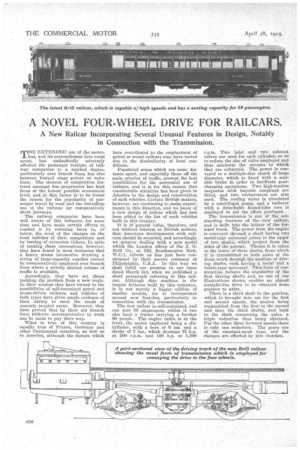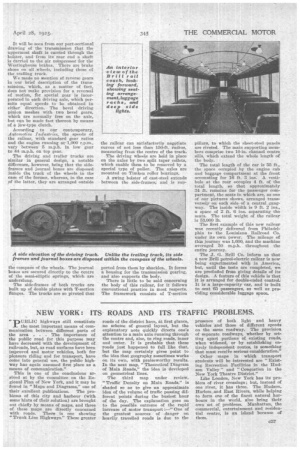A NOVEL FOUR-WHEEL DRIVE FOR RAILCARS.
Page 20

Page 21

If you've noticed an error in this article please click here to report it so we can fix it.
A New Railcar Incorporating Several Unusual Features in Design, Notably in Connection with the Transmission.
rnHE EXTENDED use of the motor.1 bus, and its encroachment into rural areas, has undoubtedly adversely affected the passenger receipts of railway companies to a marked degree, particularly over branch lines, but also between limited stage points on main lines. The element of competition fostered amongst bus proprietors has kept fares at the lowest possible economical level, and,in this factor is to be found the reason for the popularity of passenger travel by road and the dwindling. use of the railway for comparatively shortjourneys.
The railway companies have been well aware of this influence for some time and have made certain efforts to combat it by reducing fares to, or' below, the level of the charges on the road vehicles of their competitors and by issuing of excursion tickets. In spite of making these concessions, however, they have found in most instances that a heavy steam locomotive drawing a string of large-capacity coaches cannot be remuneratively employed over branch lines where a strictly ljmited volume of traffic is available.
Accordingly, they have set about tackling the problem from a new angle. In their wisdom they have turned to the possibilities of self-contained petrol and steam-driven railcars, and vehicles of both types have given ample evidence of their ability to meet the needs of sparsely peopled areas. Moreover, they have proved that by their aid branch lines hitherto unreinuiterative to work can be made to pay their way.
What is true of this country is equally true of Prance, Germany and other Continental .countries, as well as to -America, although the factors which
have contributed to the employment of petrol or steam railcars may have varied due to the dissimilarity of local conditions.
Populated areas which are some distance apart, and especially those off the main arteries of traffic, present the best possibilities for the successful use of railcars, and it is for this reason that considerable attention has been given in America to the design and construction of such vehicles. Certain British makers, however, are continuing to make experiments in this direction, and we know of a new design of railcar which has just been added to the list of such vehicles built in this' country.
It is of general value, therefore, and not without interest to British makers, that American developments with railcars should be recorded, and accordingly we propose dealing with a new model which the London offices of the J. G. Brill Co., at 150, Southampton Row, W.0.1, inform us has just been constructed by their parent company at Philadelphia, U.S.A. Inthis way we shall fulfill our promise in our issue dated March 3rd, when we Published a short paragraph referring to this railcar. Although this machine is the largest hitherto built by this company, it is not merely a bigger edition of smaller models, for it incorporates several new features, particularly in connection with the transmission.
The new railcar is self-contained, and can seat 59 passengers, whilst it can also haul a trailer carrying a further 60 people. The engine cabin is at the front, the motor employed being a sixcylinder, with a bore of 6 ids. and a stroke of 7 ins., which develops 75 h.p. at 500 r.p.m. and 190 h.p. at 1,300 r.p.m. Two inlet and two exhaust valves are used for each cylinder, so as to reduce the size of valve employed and thus minimize the stresses to which they are subjected. The power is conveyed to a multiple-disc clutch of large diameter, which is fitted with a suitable brake in order to facilitate gearchanging operations. Two high-tension magnetos with impulse couplings are fitted, and two carburetters are also• used. The cooling water is circulated by a centrifugal pump, and a radiator with a detachable finned-tube care is employed to aid the effect prOduced.
The transmission is one of the outstanding features of the, new railcar, and is built into the bolster of the forward truck. The power from the engine is conveyed through a shaft having two metal-type universal joints to the upper of two shafts; which project from the sides of the gearset. Thence it is taken to the lower of these shafts, from which it is transmitted to both axles of the front truck through the medium of driving shafts, each having a metal and a fahricAype universal. This form of construction reduces the angularity of the first driving shafts and, as one of our illustrations shows, enables an almost straight-line drive to be obtained front gearbox to axles.
There is a third shaft in the gearbox, which is brought into use for the first and second speeds, the motion being transmitted from the first to the second and then the third shafts, and baelt to the shaft connecting the axles, a triple reduction thus being obtained. For the other three forward speeds there is only one reduction. The gears are of the constant-mesh type, and the changes are effected by jaw clutches. It will be seen from our part-sectional drawing of the transmission that the uppermost shaft is carried through the bolster, and from its rear end a shaft is carried to the air compresaor for the Westinghouse brakes. There are brake shoes on all wheels, including those of the trailing truck.
We made no mention of reverse gears in our brief description of the transmission, which, as a matter, of fact, does not make provision for a reversal of motion, for special gear is incorporated in each driving axle, which permits equal speeds to be obtained in either direction. The bevel driving pinion meshes with two bevel gears, which are normally free on the axle, but can be made fast thereon by means of a jaw-type clutch.
According to our contemporary, Automotive Industries, the speeds of the railcar, with standard gear ratios and the engine running at 1,000 r.p.m., vary between 5 m.p.h. in low gear to 44 m.p.h. on top gear.
The driving and trailer trucks are similar in general design, a notable difference, however, being that the sideframes and journal boxes are disposed inside the track of the wheels in the case of the former, whereas, in the case of the latter, they are arranged outside the compatis of the wheels. The journal boxes are secured directly to the centre of the semi-elliptic springs, which are underslung.
The side-frames of both trucks are built up of double plates with T-section flanges. The trucks are so pivoted that the railcar can satisfactorily negotiate curves of not less than 150-ft. radius, measuring from the centre of the track.
The driving wheels are held in place on the axles by two split taper collets, which enable them to be removed by a special type of puller. The axles are mounted on Timken roller bearings.
A swing bolster of cast-steel extends between the side-frames, and is sup ported from them by shackles.. It forms a housing for the transmission gearing, and also supports the body.
There is little to be said concerning the body of this railcar, for it follows conventional practice in most respects. The framework consists of T-section
pillars, to which the sheet-steel panels are riveted. The main supporting members comprise two 10-in, channel centre sills, which extend the whole length of the body.
The total length of the car is 55 ft., the space occupied by the engine cab and baggage compartment at the front accounting for 16 ft. 3 ins. A vestibule at the rear occupies 4 ft. of the total length, so that approximately 34 ft. remains for the passenger compartment, the seats in which are, as one of our pictures shows, arranged transversely on each side of a central gangway. The inside width is 9 ft. 2 ins., a apace of 2 ft. 6 ins. separating the seats. The total weight of the railcar is 53,000 lb.
The first example of this new railcar was recently delivered from Philadelphia to the Louisiana Railroad Co. under its own power. The mileage of this journey was 1,600, and the machine averaged 50 m.p.h. throughout the entire journey.
The ff. G. Brill Co. inform us that a new Brill petrol-electric railcar is now being experimented with in America, but, until the tests are completed, we are precluded from giving details of its design. A feature of this vehicle is that it is arranged for double-ended control) It is a large-capacity car, and is built to seat 65 passengers, as well as providing considerable luggage space.
































